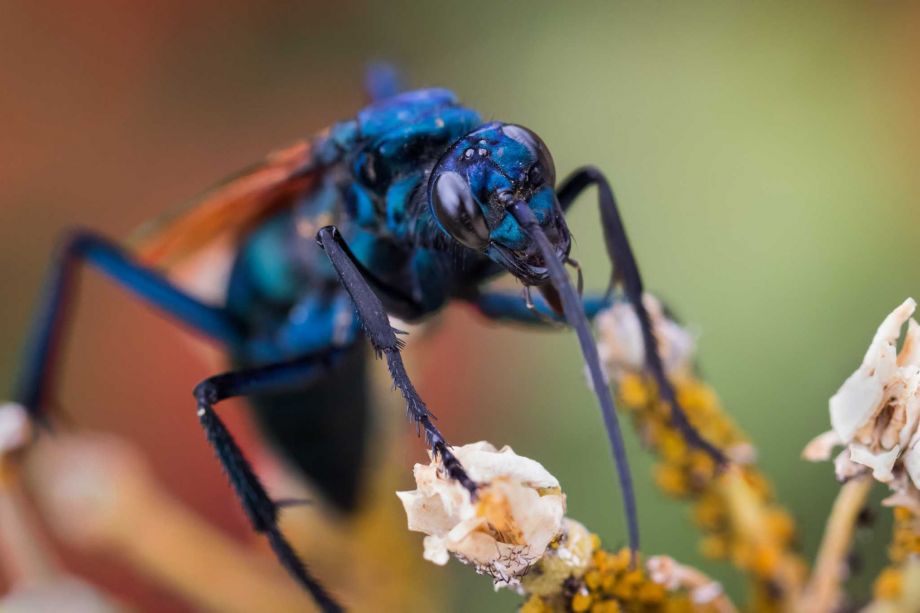Our first evening in Hueco Tanks, just outside of El Paso, and the home to some of the best bouldering in the world, I was treated to my first glimpse of the Tarantula Hawk. It was a brilliant – almost sparkly – blue creature with dazzling orange wings and a stinger nearly half an inch long. It was clear upon first glance that this was not one to be messed with. The insect was walking across the cement I had perched myself on, mere inches from my leg, with a demeanor of owning the world. Out of the corner of my eye, the sheer size of it made me think at first that it was one of the massive roaches that are common around Texas. While I’m not a fan of roaches, in this situation, I would have found that preferable. Instead, I was looking at (or rather, quickly scampering away from) the largest – albeit prettiest – wasp I had ever seen in my life.
The next day, we asked a park employee about the insect, and were informed that they are called Tarantula Hawks. As if that doesn’t sound daunting enough, we quickly learned where the name comes from. In order to reproduce, the wasp will sting a tarantula – paralyzing it – and lay a single egg in its abdomen. When the larva hatches, it feeds off the tarantula, avoiding vital organs in an effort to keep the tarantula alive as long as possible. Eventually, it reaches its adult state and emerges from its host spider.
At this point, I found it necessary to do a little more research about the creatures and looked up information about their sting. I really wish I hadn’t. According to the Schmidt Sting Pain Index (a crazy entomologist went around the world getting bit by various insects in order to rank the pain levels of each bite), the Tarantula Hawk sting is the second most painful sting in the world. The internet was full of wonderful descriptions:
- “It felt like a thousand flaming daggers being stabbed into my arm. I actually screamed from the pain, which I never do, and then ran back to my house like a mad cow. I slapped my arm as hard as I could to dilute the pain, and put block of ice on it, but the pain was so excruciating those things were futile. I have never felt such intense pain in my life.”
- “Immediate, excruciating pain that simply shuts down one’s ability to do anything, except, perhaps, scream. Mental discipline simply does not work in these situations.”
- “Blinding, fierce, shockingly electric. Like a running hair dryer has been dropped into your bubble bath.”
Most sites said that if you see one, you should go inside immediately. Unfortunately, that wasn’t really an option for us camping out in the desert. The only consolation is that the pain lasts for less than 15 minutes (and then disappears like nothing ever happened), and they only attack if provoked.
We spent our next two nights at Hueco Tanks screeching like scared little girls and ducking around corners every few minutes when another one of these creatures would fly close to us. Every time we would turn on the water faucet (which happened a lot considering that we were camping in a desert where the temperatures were hitting 105 degrees each day), they would soon appear, usually in groups of three or four. We quickly learned to identify the buzz of a Tarantula Hawk from that of other, less terrifying, insects; of course, it was easy, since the massive insect sounded like a helicopter. In the late afternoon when the insects were most prevalent, we tried hiding out in our tents until we were so sweaty we couldn’t take it anymore, occasionally braving the possibility of getting stung in order to cook dinner and/or hang out.
At this point, I also discovered that there were two tarantula hawks hanging out in the shower portion of the women’s bathroom. Climbing in extreme heat isn’t the best for hygiene, so despite seeing one hanging out in the corner, I bravely stripped off my clothes and entered the shower. Less than ten seconds later, the sight of a second one swooping into the shower stall was enough to send me tearing out of the shower, butt naked. I hurriedly threw my clothes on and ran back to camp, proclaiming – to everyone’s dismay – that I would no longer be showering on this trip (thankfully there was only one day left).
Fortunately, we never saw one of them during the day when we were out climbing… until the last day. We headed out near Mushroom Boulder/Melon Patch because John and Andrew wanted to do some sport climbs (I opted out due to exhaustion/actually listening to my healthy sense of fear). While known for its bouldering, Hueco Tanks also has some incredible sport climbs that are bolted so sparsely that it adds another level of terror to leading. In case that wasn’t enough, the tarantula hawks buzzing near the ground didn’t let up as they climbed higher. I can’t even imagine what would have happened if one of them had been stung during the climb; the person leading might have lost all control and taking a big fall, or worse yet, the belayer could get stung and lose the ability to help. Thankfully, the only sting they received was from a regular bee about halfway up the climb. When the pain from the bee sting lasted through the next day, we joked that maybe John would have been better off with a tarantula hawk sting…
We survived the trip without anyone experiencing the sting of those Helicopter Death Machines (as we dubbed them), but our whole trip was defined by them since we spent the entire time running scared, hiding in tents, avoiding showers, avoiding water, etc.

Leave a Reply